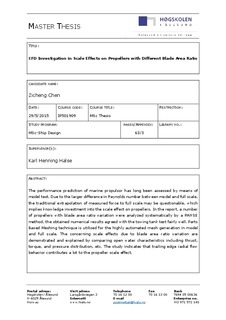| dc.contributor.author | Chen, Zicheng | |
| dc.date.accessioned | 2015-09-22T10:46:13Z | |
| dc.date.available | 2015-09-22T10:46:13Z | |
| dc.date.issued | 2015 | |
| dc.identifier.uri | http://hdl.handle.net/11250/301126 | |
| dc.description.abstract | The performance prediction of marine propulsor has long been assessed by means of model test. Due to the larger difference in Reynolds number between model and full scale, the traditional extrapolation of measured force to full scale may be questionable, which implies knowledge investment into the scale effect on propellers. In the report, a number of propellers with blade area ratio variation were analyzed systematically by a RANSE method, the obtained numerical results agreed with the towing tank test fairly well. Parts Based Meshing technique is utilized for the highly automated mesh generation in model and full scale. The concerning scale effects due to blade area ratio variation are demonstrated and explained by comparing open water characteristics including thrust, torque, and pressure distribution, etc. The study indicated that trailing edge radial flow behavior contributes a lot to the propeller scale effect. | nb_NO |
| dc.language.iso | eng | nb_NO |
| dc.rights | Navngivelse-Ikkekommersiell-IngenBearbeidelse 3.0 Norge | * |
| dc.rights.uri | http://creativecommons.org/licenses/by-nc-nd/3.0/no/ | * |
| dc.subject | CFD | nb_NO |
| dc.subject | Propeller | |
| dc.title | CFD investigation in scale effects on propellers with different blade area ratio | nb_NO |
| dc.type | Master thesis | nb_NO |
| dc.subject.nsi | VDP::Technology: 500::Marine technology: 580::Ship technology: 582 | nb_NO |
| dc.source.pagenumber | 63 | nb_NO |

